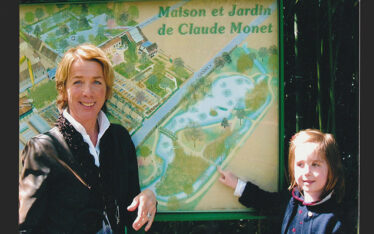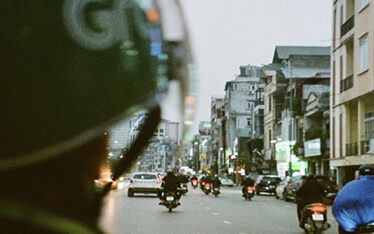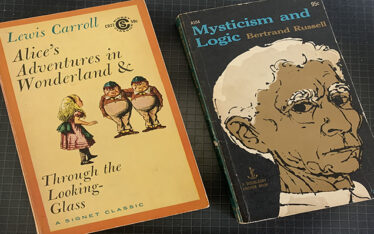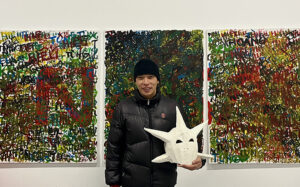
Motorbikes slalom between fresh flashy cars. Local vendors sell along the curbside of supermarkets and shopping malls. Quaint narrow streets are adorned with bold-lettered acronyms and neon lights — Circle Ks, KFCs, Burger Kings, Mackey Ds. The bodies that zip through them with Dolces and Guccis (more realistically, knockoff Cuccis).
New capitalism in Vietnam. It is, in fact, alive and well.
It’s been approximately thirty years since Vietnam first initiated its Đổi Mới economic reforms. Against this backdrop of a newly globalized market, consumerism runs rampant. While Gen X witnessed the country transition from subsidized economy to market-oriented, Gen Zers were born directly into the latter.
From colonization to wartime to isolation to globalization: the predicament within which one thinks about identity in Vietnam today is other-worldly compared to 20 years ago, let alone 50 — as is the need to think about it in the first place.
With so many moving pieces uniquely inherent to the post– Đổi Mới reality, tuổi trẻ ở Việt Nam ngày nay có nghĩa là gì? What does it mean to be young in Vietnam today?
Saigon-based artist Nguyễn Vũ Trụ’s 3-month residency at á space offered a playful exploration into this question of time, place, and, of course, identity. Through five “missions” – the residency being divided into five stages of protocol for artists to follow –, Vũ Trụ, the curator Quỳnh Chi, and 10 other Hanoi-based artists – or “astronauts” as often referred to–, delved into the possibilities of defining what Vietnamese implies for them today. This was most explicitly illustrated through Mission #2, as artists were required to place a “Vietnamese High-Quality Product” sticker on ten items of their choice. The yellow checkmark soon became an emblem for the residency as a whole.
“Hàng Việt Nam Chất Lượng Cao” có nghĩa là gì? What does it mean for something to be a “Fine Quality Vietnamese Product”?
RMIT University Vietnam categorizes Gen Z as all those born between 1996 and 2012. Funny enough, ’96 is also the year the Business Association of Vietnamese Fine Quality Goods was founded. Their website defines the Association’s work as “accelerating activities to support businesses to innovate, change technology and penetrate international markets in production and business.” Setting a standard for domestic supply, “Vietnamese Fine Quality Goods” came as a stamp to secure Vietnam’s competitive place on the global market.
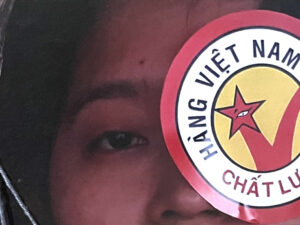
This symbol of Vietnam’s recent socio-economic chapter is everywhere. From notebooks to fish sauce, to yogurts, to diapers, to toothpaste, to beer cans. NÁSA – the title of three month art residency — entailed ten young Viet artists dialoguing with this marker of contemporary times, re-appropriating a signifier intended for market value, and in turn re-endowing it with newfound meaning – from absent-minded consumerism to reflective introspection.
I sat down with Vũ Trụ at á space for a better understanding of the residency and the subsequent dialogues it prompted.
For context: Á Space is an independent non-profit art space based in Long Biên, Hà Nội. Established in 2018 by Tuấn Mami, Rory Gill, and Lê Dụng Hiệp, the space works to support independent local artists as well as further develop Vietnam’s domestic art scene. The current Curatorial Board of Á Space includes Vân Đỗ, Hà Ninh, Linh Lê, Vũ Đức Toàn, Châu Hoàng, and Đặng Thuỳ Anh. Through collaborations with artists, curators, and researchers from both Vietnam and the international sphere, the á space team seeks to foster dialogue and community through interdisciplinary art practice.
Caroline Levin: How would you define NÁSA?
Vũ Trụ: I want to disclaim that NÁSA is a collaborative project. So, what you’re getting [through this interview], is only one perspective of what NÁSA could be. It really was a child of ten-to-twelve people and I was just a very small part within that whole network and community.
NÁSA is an experimental art program disguising itself as a fake space program, initiated from last year with curator Quynh Chi. We met each other at Galerie Quynh in Saigon, where we both previously worked at. We talked for a long time about how we always wanted to do an exhibition together. And the opportunity came up. Chi was chosen by á to be the curator-in-residency who got to choose the accompanying artist. She called me when I was still living in Australia.
The residency was at first designed to show work that I’ve done in the past few years, using what I’ve discovered within my own practice and sharing it with ten other people taking part in the residency. There’s a term that I coined after this exhibition, just after seeing everyone’s work done and up and just having the time to reflect: “collective dreaming”.
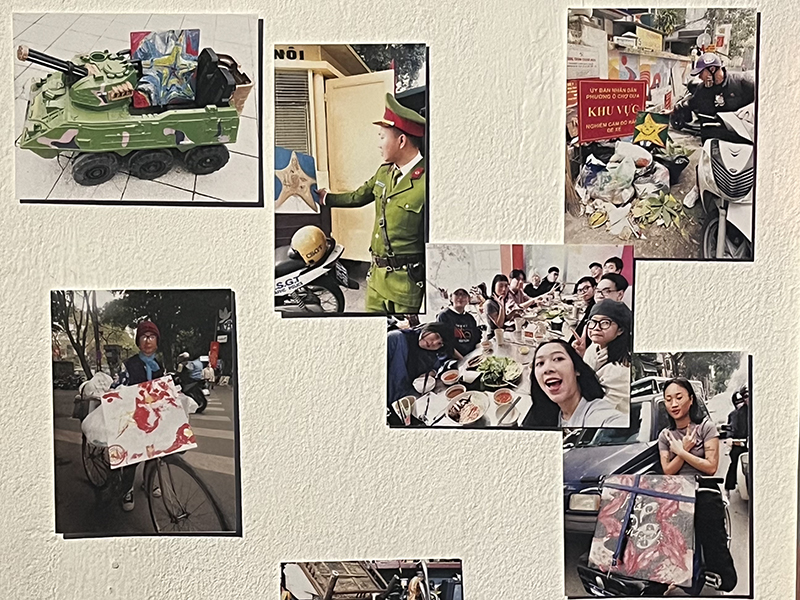
I don’t think we’re a collective. We do collaborations and we’re a community. All of us are very different and I think all of us were there for our own reasons. I’m not too great as a program designer to be honest. I didn’t even know what the final outcome was going to be. The term “collective dreaming” speaks to the honesty of our accumulated work. And I think that’s what NÁSA is for.
For me, NÁSA is using the residency as a place to hang out with people. To talk to these people — as a reason to connect with them, to discover their narratives. When I first proposed this exhibition, I knew I wanted to work with ten other people. I wanted to discover what makes them do their art. It’s a platform for those voices as well to be heard.
CL: Why the space theme?
VT: I’ve always been into space. As a kid I dreamt of being an astronaut – a pretty common dream between kids. But you know, as an Asian kid, it didn’t seem realistic. But I loved space anyways because growing up in Vietnam, my first interaction with computer technology was from what my mum printed out. There were these mystery articles from VN Express, an online newspaper. She’d print these articles about the next meteor shower or the latest planet discovery. Those things stuck with me. I also grew up on a lot of sci-fi, watching sci-fi movies, a lot of Doctor Who. I always felt like there is a lack of representation. Sci-fi is a bit of a western genre. And so, there are no Asian narratives being told within the sci-fi realm.
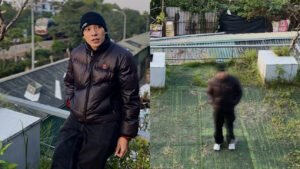 I think a lot about the future: what the future will look like? And especially, what will Vietnam be in the future? That’s essentially why NÁSA is built around astronauts and space.
I think a lot about the future: what the future will look like? And especially, what will Vietnam be in the future? That’s essentially why NÁSA is built around astronauts and space.
CL: Why the Viet Fine Quality Product focus?
VT: High Quality Vietnamese product stickers have been a way for me to express my feelings, my anxieties, and fears. I first used them in paintings, through which I expressed fear of my identity, or fear of global warming — the time of the ice melt instead of the Ice Age–, fear of war, etc. I used that sticker in order to ask if my feelings and anxieties were valid enough to be considered “Vietnamese High-Quality Products”, to be a part of Vietnamese art history, in a sense, to be considered artworks.
I wanted to share that motif with the astronauts as I feel like that motif of this sticker is very synonymous with Vietnamese consumer culture. Anyone in Vietnam has seen that sticker before. […] I wanted to get other people to use it to express themselves as well. And so, through that, I gave each of the astronaut ten stickers and asked to see around them: what do they consider a Vietnamese High-Quality Product? That delves into the question of asking oneself “what is Vietnamese?” which goes into identity. Using that motif has led me to ask questions. And so, I’ve given that motif to people for them to ask questions about themselves, about the world around them.
Each person had their own approach. Some people dealt with it quite sincerely, slapping the sticker on something they considered quite endearing to them. Or onto a memory. Sometimes quite abstract. Some people went through irony. That sticker then becomes a marker for a question, for a dialogue. Through that, I discovered what the people see in their daily life.
CL: What were some of your most memorable experiences from your time in the residency?
VT: Seeing people grow. Seeing myself grow and the other ten astronauts come out of their shell to explore more mediums than what they’re attuned to. There was a mix of people: those who were having first toes dipped into making/ thinking about art, I thought it was a nice platform to have that space to explore and express. For the ones a bit more established, seeing the different mediums they experimented with was really cool — to see how they moved away from their comfort zone. Vân Đơ, [á space curator and artistic director], told me we were brave to be so honest. It’s not so easy to show yourself like that. To show what we care about in our daily lives.
CL: How would you describe your experience working in Hanoi as a city?
VT: From this experience, I love Hanoi a lot more — a little bit deeper. Just the people and neighborhood I got to explore during my time there. To be able to see so many artists, and work with them from different generations. It’s been so fun as well. I felt like there were certain standards within the art scene that I didn’t want to uphold. I was there for fun.
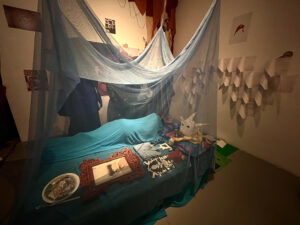 Overall, it’s been amazing. It was with my actual peers, my astronaut friends, that I learned the most from. There were influences like Tuan Mami who I really loved talking to — we literally lived in the same house. It was really through my friends and co-artists that I learned the most. But having that network of support, older people, people my age, and seeing the audience as well of Hanoi come to see the exhibition – that as well was quite cool.
Overall, it’s been amazing. It was with my actual peers, my astronaut friends, that I learned the most from. There were influences like Tuan Mami who I really loved talking to — we literally lived in the same house. It was really through my friends and co-artists that I learned the most. But having that network of support, older people, people my age, and seeing the audience as well of Hanoi come to see the exhibition – that as well was quite cool.
CL: Was the audience turnout different from what you’re used to in Saigon?
VT: Hanoi has a scene. Saigon feels like there’s a lot happening at once. Your friends will come to support you. With the Hanoi scene, it was nice to have that scene of people/ community showing up. In Saigon, it’s a bit dispersed, everyone is working on their own thing. There’s not a lot of mentorship in Saigon, unless you go to find it. This is my subjective experience; I can’t speak broadly for the Saigon versus Hanoi art scene comparison. There’s a good ecosystem in Hanoi for experimental art.
CL: Who are your artistic inspirations? For context, I had asked Nguyễn Văn Cường 1. who his inspiration was as an artist starting off in the 90s — he has responded Van Gogh. I thought it was interesting talking to you for the first time about Vietnamese contemporary art, this diversity of previous generations who you admired.
VT: One of my biggest inspirations is Tuấn Andrew Nguyễn. I think about his work most days. I think about his ethics, the way he makes art, who he makes it for. He’s one of my biggest inspirations. But also, I find new inspiration every day. Every temple I go to, every person I get to meet.
When I first discovered what contemporary art is, reading online at age 18/ 19, I was quite enamored with abstract expressionists, and pop-artists also from New York. It looked quite glamorous. As has been the narrative built for those artists. I guess as a teen I wanted that… the mythical nature of the artist. The great Warhol, Rothko, etc.
I self-educated on contemporary art history. And [my knowledge] is still very Western-based. Those are the first people I looked at. But after being able to intern in Saigon at Galerie Quynh, that’s when I was able to meet with actual Vietnamese contemporary artists and realize “holy s**t Vietnamese art is so f**king cool”. It’s a shame that for so long I’ve known more Western contemporary art versus Eastern art.
When I was 19, I made an ASMR video artwork where I found a list of 200 greatest artists in the world, mostly western artists, and whispered “F**k you … [established Western artist]”. It went on for 6 minutes. Á showed it at an experimental film screening. I have a love-hate relationship with the Western artists. Their art is cool, but a lot of the famous ones are also a**holes.
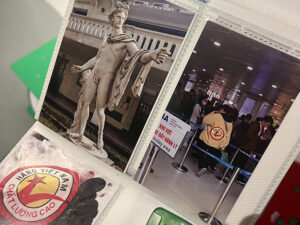 CL: It was interesting to see the combination of inspiration at play throughout NÁSA. For example, the title of the exhibition, “Love is in The Air”, draws influence from American writer Bell Hooks. I gathered the idea came from Quỳnh Chi and her own curatorial practice. It demonstrates a multiplicity of references woven in, speaking to a bit of a complicated cultural environment.
CL: It was interesting to see the combination of inspiration at play throughout NÁSA. For example, the title of the exhibition, “Love is in The Air”, draws influence from American writer Bell Hooks. I gathered the idea came from Quỳnh Chi and her own curatorial practice. It demonstrates a multiplicity of references woven in, speaking to a bit of a complicated cultural environment.
VT: For sure. It’s a super strange landscape to try to navigate. Also, today there’s so much available on the Internet so the influences are pulled from so many places. In recent years, I would say some of my favorite artists are Vietnamese. There’s definitely a bias but it’s just their mode of operation, the way they approach art, that feels a lot more homely to me. For example, finding out about Tuan Mami’s immigrating garden. The idea of making a garden in a museum — it seems so simple, but the way he engages the Viet community in a new city… it’s so beautiful. Get museum money and make a space for Viet people. It’s so cool. And to see art in a way that isn’t so ‘grand’. There’s also an artist I love, Nguyễn Vũ Xuân Hạ, the founder of Asong Collective. Seeing her performances where she invites people to eat dinner, make spring rolls with her… things like that. They hit so much better for me rather than these grand illusions on what great art is. Seeing the love within contemporary Vietnamese art, seeing the heart that artists put into their work… that’s how I want the future of my artmaking to be as well.
 –––––––––––––––––––––––––––––––––––––––––
–––––––––––––––––––––––––––––––––––––––––
Unlike the chef-de-fils experimental Viet artists of the 90s, this new generation unprecedently has precedent (repetitive tongue twister) to interact with: for starters, they have a growing archive of contemporary Vietnamese art to admire, contemplate, and draw inspiration from rather than solely looking at the standard reservoir of Western art names; furthermore, given how recently the initial chapter of contemporary art taking off occurred, the younger generation — such as Vũ Trụ and fellow astronauts –, can turn to their predecessors for guidance and opportunity. This was illustrated with the á space residency itself – á having been founded by internationally acclaimed Tuan Mami to provide up-and-coming Viet artists with resources to both grow and exhibit their work at home rather than needing to go abroad. In a global context where much of Viet identity has been defined through representations of the clichéd exotic or victimhood under war, the domain of contemporary art has provided an alternative space for Viet youth to articulate identity, through the prism of empowerment.
Vũ Trụ’s residency speaks to a “spirit of friendship” that has defined much of how the domestic art scene in Hanoi has developed/ been sustained since the 90s up to date.2. Against a backdrop of booming commercialization, curating a creative space intended for friends rather than bending to the will of the Western art market is not negligible.
Finally, the aesthetics and subject matters explored throughout the NÁSA residency point to the possibilities of thinking of the future of contemporary Vietnam beyond surface level labels and decorum: possibilities that do not just entail consuming, but digesting — contemplating. Following this sit-down talk, I was marked by an impulse from Vũ Trụ and his fellow NÁSA artists to understand, express and converse thoughts and feelings premised on the meaning of living in Vietnam today, be it through spoken word, such as this interview, or via an abstract visual language. Or even just through moments shared in creative company.
––––––––––––––––––––––––––––––––––––––––––––––––––––
‘Hàng Việt Nam Chất Lượng Cao’ có nghĩa là gì? What does it mean for something to be a ‘Fine Quality Vietnamese Product’?
Tuổi trẻ Việt Nam ngày nay có nghĩa là gì? What does it mean to be young in Vietnam today?
As an outsider, I am in no place to propose an answer. However, after speaking with Vũ Trụ, I do have a sense of the seeds being planted for further dialogue on the matter: friendship, community, empowerment through creativity — the quest to explore these questions is not to be done alone. Perhaps it is in the process of this exploration where lies the real insight, rather than the finished work. The seeds and the “collective dreaming” of how they will grow rather than the garden already flourished.
_________
footnotes:
1. Chef-de-fils contemporary Vietnamese artist who contributed to the experimental 90s boom .
2. Butt, Zoe, et.al. “Spirit of Friendship.” The Factory Contemporary Arts Centre, 29 Sept. 2017, factoryartscentre.com/en/event/spirit-of-friendship/.
(c) 2024 Caroline Levin. All rights reserved.
About the Article
An interview in Hanoi with a contemporary Vietnamese artist.

